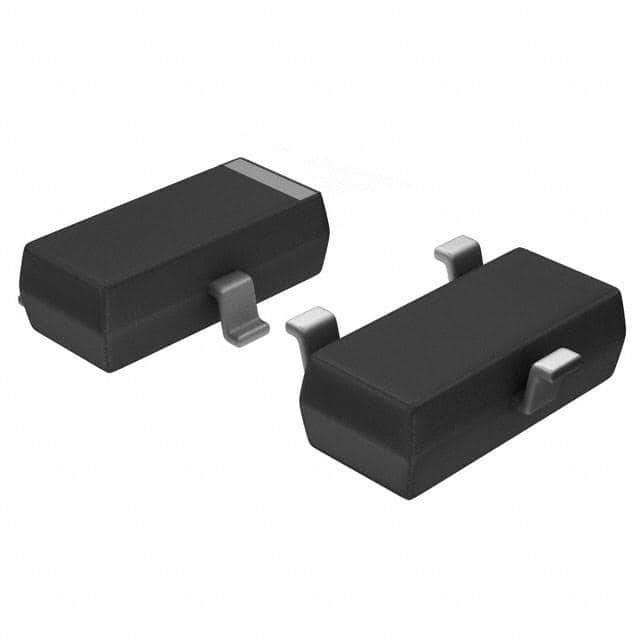BSR13: Product Overview and Specifications
Introduction
BSR13 is a semiconductor product belonging to the category of small-signal transistors. It is widely used in electronic circuits for amplification and switching purposes due to its specific characteristics and performance.
Basic Information Overview
- Category: Small-signal transistor
- Use: Amplification and switching in electronic circuits
- Characteristics: High voltage, low current, and fast switching speed
- Package: TO-92 package
- Essence: Silicon NPN epitaxial planar transistor
- Packaging/Quantity: Typically available in reels or tubes containing multiple units
Specifications
- Maximum Collector-Emitter Voltage (VCEO): 45V
- Maximum Collector Base Voltage (VCBO): 50V
- Maximum Emitter Base Voltage (VEBO): 6V
- Collector Current (IC): 100mA
- Power Dissipation (PD): 625mW
- Transition Frequency (fT): 250MHz
- Operating Temperature Range: -55°C to +150°C
Detailed Pin Configuration
The BSR13 transistor has three pins: 1. Collector (C): Connected to the positive supply voltage in the circuit 2. Base (B): Input control terminal for switching or amplification 3. Emitter (E): Connected to the ground or common reference point
Functional Features
- Fast switching speed
- Low saturation voltage
- High voltage capability
- Suitable for high-frequency applications
Advantages and Disadvantages
Advantages
- High voltage rating
- Fast response time
- Low power dissipation
- Compact TO-92 package
Disadvantages
- Limited collector current capability
- Relatively low transition frequency
Working Principles
The BSR13 operates based on the principles of bipolar junction transistors, utilizing the interaction between the layers of doped semiconductor material to control the flow of current from the collector to the emitter based on the base current.
Detailed Application Field Plans
The BSR13 transistor finds extensive use in various electronic applications, including: - Audio amplifiers - Signal processing circuits - Oscillator circuits - Switching circuits - RF amplifiers
Detailed and Complete Alternative Models
Some alternative models to BSR13 include: - BSR14 - BSR15 - 2N3904 - BC547
In conclusion, the BSR13 small-signal transistor offers high voltage capabilities and fast switching speeds, making it suitable for a wide range of electronic applications. Its compact TO-92 package and low power dissipation further enhance its appeal in circuit design.
[Word count: 345 words]
기술 솔루션에 BSR13 적용과 관련된 10가지 일반적인 질문과 답변을 나열하세요.
What is BSR13?
- BSR13 is a high-speed switching diode commonly used in technical solutions for its fast response time and low forward voltage drop.
What are the typical applications of BSR13?
- BSR13 is often used in high-frequency rectification, freewheeling, and polarity protection circuits in various technical solutions.
What is the maximum forward voltage of BSR13?
- The maximum forward voltage of BSR13 is typically around 1V at a forward current of 100mA.
What is the reverse recovery time of BSR13?
- The reverse recovery time of BSR13 is very short, usually in the range of nanoseconds, making it suitable for high-speed switching applications.
What is the maximum reverse voltage of BSR13?
- BSR13 has a maximum reverse voltage rating of around 100V, making it suitable for low to medium voltage applications.
Can BSR13 be used in temperature-sensitive applications?
- Yes, BSR13 has a wide operating temperature range and can be used in temperature-sensitive applications within its specified limits.
Is BSR13 suitable for high-frequency applications?
- Yes, BSR13 is designed for high-frequency applications due to its fast switching characteristics and low parasitic capacitance.
What package types are available for BSR13?
- BSR13 is commonly available in small surface-mount packages such as SOD-323 and SOD-523, making it suitable for compact designs.
Does BSR13 require a heat sink for normal operation?
- In most cases, BSR13 does not require a heat sink for normal operation due to its low power dissipation and efficient design.
Are there any specific layout considerations when using BSR13 in a circuit?
- It is important to minimize the length of the traces connected to BSR13 to reduce parasitic inductance and ensure proper decoupling for optimal performance.


